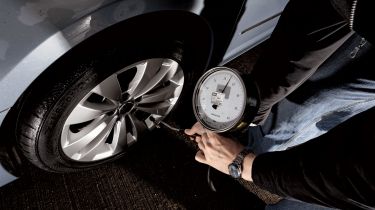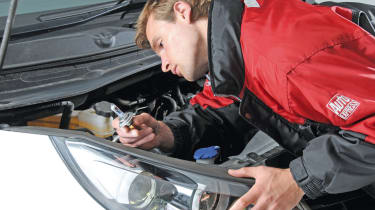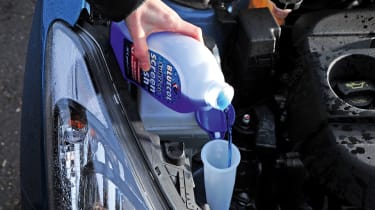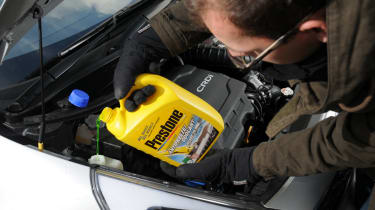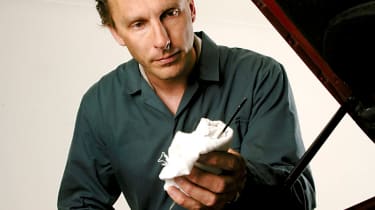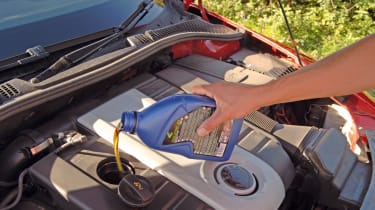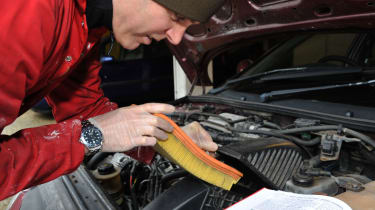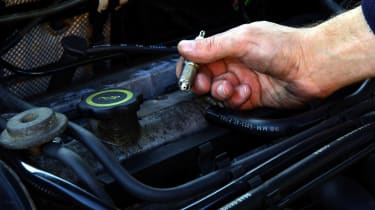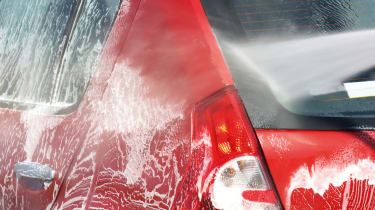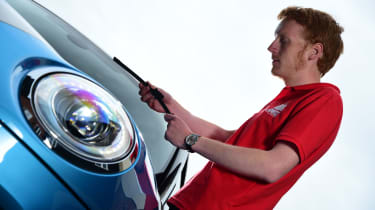The DIY car maintenance you can't ignore
Did you know there are plenty of maintenance jobs you can do – such as checking your tyres’ condition – quickly, easily and cheaply?
Armed with little more than a bit of know-how and a few basic tools, the savvy motorist can save a packet on car maintenance.
We’ve picked some of the most straightforward and useful basic car maintenance tips you can do to keep your car safe and running at its peak efficiency. We’ve ranked them out of five, but all can be carried out with a little bit of time and a small number of affordable tools.
Most of the parts we’ve listed below will be specific to your car, so tell your car spares shop or main dealer the make, model, engine size and year of your car to ensure they supply the right bits. Your registration number will be useful for this, too.
What you won’t find here is an oil-change guide. That’s because it’s a messy job that can be fraught with difficulties. For the sake of your sanity, car and a clean driveway, it’s a job best left to the experts.
But remember, if you’re struggling with any of these tasks, then call your local garage or main dealer, who’ll be more than happy to help.
Read on for our DIY car maintenance checklist…
Tyre condition
Difficulty rating: 1/5
Ensuring your tyres are in good condition is the most important single thing you can do. Fortunately, it’s also one of the easiest. The Highway Code recommends you check your tyre pressures once a week. But while you’re doing that, you may as well check your general tyre condition and wear, too.
To check your tyre pressure, first locate your car’s tyre-pressure chart, which is usually printed on the frame inside one of the doors, inside the fuel filler cap or in your car's handbook. It’ll tell you the correct pressures for your car – under normal circumstances and if you’re carrying more passengers or lots of luggage.
Because heat can cause the air in your tyres to expand, wait until your tyres are cold for a more accurate reading. Remove the tyre valve’s dust cap and screw or attach a tyre-pressure gauge onto the valve to get a reading. These are available from car spares shops across the country. Alternatively, you can use a gauge on a tyre foot pump or an air line in a petrol-station forecourt.
The tyre’s pressure will be displayed in the gauge. If the pressure is low, use a pump to inflate it to the correct amount.
While you’re crouched by the tyre, check for gouges or cuts around the tread and sides of the tyre. If you see a screw or a nail in the tread, don’t remove it, as it could deflate the tyre. Instead, drive slowly to your local tyre fitter or main dealer. Some damage can be repaired cheaply, but depending on where exactly the nail has gone in, you may need to get a new tyre.
Finally, check the tyres’ tread depth. You can use a tyre tread-depth gauge, which costs a few pounds from most car spares shops. Or you can use a 20p coin, as the outer rim is approximately 3mm thick – the recommended minimum depth that you should drive on.
Insert the coin into the tread. If you can see any of the outer rim of the coin, then you’ll need a new tyre soon. A depth gauge works in exactly the same way, but will give a more accurate reading. Don’t forget to check across the width of the tyre and at several points around the tyre’s circumference.
The Highway Code says tyres need to “have a tread depth of at least 1.6mm across the central three-quarters of the breadth of the tread and around the entire circumference”.
Light bulbs
Difficulty rating: 3/5
We’ve given this a three out of five difficulty rating, but the truth is that depending on your car, it can be a two-minute job or a two-hour, knuckle-grazing nightmare. Older cars are usually easier, but modern cars often have very poor access to the back of the headlight units. It’s worth bearing in mind that some car spares shops, and even main dealers, will change them in a fraction of the time it could take you.
Most headlight bulbs are secured by metal clips that sit behind plastic covers. Once you’ve removed the trim and the plugs that connect to the bulb’s terminal, take off the clip and the bulb should slide out. Remove the bulb (taking care it’s not hot) and slide the new bulb in without touching the glass. Reconnect the plug and replace the clip and cover and you’re ready to check the new bulb works.
Rear lights (often called tail-lights) are usually easier to maintain, because access is usually easier. You’ll need to unclip the interior trim panel in the boot before unclipping the bulb holder. In most cases, a single holder will contain all of the bulbs. Most tail-light bulbs use a bayonet-type fitting, so you need to press the bulb in gently and twist – a bit like a childproof medicine bottle. Reverse this process to finish.
Windscreen washer fluid
Difficulty rating: 1/5
This really couldn’t be easier. Locate the windscreen washer bottle cap, which will usually be located under the bonnet and have a windscreen washer jet symbol printed on top. The lid usually unclips, so if you’ve found a bottle with a screw top, then you’ve likely got the wrong one. Double-check in your manual to be sure.
Once you’ve removed the lid, use a funnel to top up the fluid. Dedicated screenwash fluid is better than water or water mixed with washing-up liquid, as it doesn’t freeze as easily and contains detergent to shift dirt. Ready-mixed or concentrated screenwash (that you need to mix with water) are both available.
Fill the screenwash bottle to near the top and replace the lid.
Antifreeze
Difficulty rating: 3/5
Antifreeze does exactly what it says on the tin – stops the water in your engine from freezing. It’s also called coolant, because the same chemicals stop the water pumped around the engine to keep it cool from boiling, leaving you stuck at the roadside in a cloud of steam. Which is why you should never use water alone.
The coolant reservoir will be under the bonnet and is identifiable by warning stickers on the lid. It’s vital you find the right bottle, so check your car’s handbook. Before you remove the lid, check the engine is cool, as the antifreeze can get extremely hot.
After making sure your engine is cold and your car is parked on a level surface, check how much liquid is inside by locating the minimum and maximum marks on the bottle. The fluid shouldn’t be above maximum or below minimum – if it's the latter, it’ll need topping up.
The properties that stop antifreeze from boiling or freezing don’t last forever, so it needs replacing every few years. Coolant testers are available from car spares shops and generally provide an accurate reading of whether your coolant is still able to do its job.
Different types of antifreeze are available, so check your car's handbook or with your main dealer to ensure you buy the correct fluid. Whatever you choose, you’ll need to mix the antifreeze with water. The ratio of antifreeze to water depends on how cold the weather will get, but a 50:50 mix is about right for most cars in the UK. Even so, check your handbook or with your dealer for official recommendations.
Remove the coolant reservoir cap and top up to the maximum mark. Use a funnel to avoid dripping the liquid, as it can damage your car's paintwork.
Checking your oil
Difficulty rating: 1/5
This is another important check that’s really easy. Make sure the engine is cool and the car is parked on level ground to ensure you get an accurate reading. Locate the dipstick, which will usually have a yellow or orange handle and will be located near the engine. Again, your car’s handbook will help here.
Remove the dipstick, taking care not to drip any oil, and wipe with a piece of kitchen roll. Replace the dipstick fully and remove again. You’ll see the oil will have stuck to the dipstick somewhere between the minimum and maximum marks. If it’s on or around maximum, you’re fine. If not…
Topping up your oil
Difficulty rating: 2/5
Should your dipstick indicate your oil is on or around the minimum mark, it’s time to top it up. It’s vital you use the correct grade and type of oil to avoid engine damage or invalidating your car’s warranty. Your handbook or main dealer will be able to give you this information.
Grades of oil are usually referred in numbers and letters such as 10W-30, and synthetic and non-synthetic types are available.
When the engine is cool, find the oil filler cap, which will be located on top of the engine. It’ll usually be indicated by an oil can symbol. It’s a good idea to brush any dirt or debris away from the area to avoid it falling inside the engine when you remove the cap.
Once the tap is removed, use a funnel and slowly pour the oil into the engine. Wait for a few moments for it to work its way inside the engine and check the depth using the dipstick – the level should be just below the maximum mark. Pour in more oil if necessary, but don’t overfill. Replace the dipstick, screw the oil cap back on and wipe away any oil that’s been spilt.
Air filter
Difficulty rating: 2/5
The air filter does an important job of removing dust and debris from the air before it enters your engine, so keeping it clean is essential. Most air filters sit in a plastic box mounted to the side of the engine. You’ll need to undo a few metal clips or screws to release the top of the air box. Once off, you’ll see the air filter, which is usually yellow with an orange edge. Make a note of which way round it goes, remove it and drop the new one in its place. Replace the lid, do up the clips and you’re there.
Spark plugs
Difficulty rating: 4/5
It’s hard to overstate the importance of spark plugs. They emit a spark at exactly the right time to ignite the fuel in your engine, so they must be kept in good health. But because they trigger those tiny explosions in the engine, they get covered in sooty deposits over time and will need replacing every few years.
Speak to your local dealer or car spares shop to ensure you buy the correct parts, as they’re all slightly different.
The exact process varies from car to car and older cars use a different setup to modern models. Whichever system your car has, you’ll need to make sure the engine is cool and that you only change one spark plug at a time
Most modern cars today use ignition coils, which are plastic-covered units attached to the top of your engine. Check with your dealer to find out how to locate them. Using a socket, remove the securing bolt, unclip the wiring harness and gently remove the coil one at a time.
Older cars have ignition leads (also called HT leads) connecting to each spark plug, which will need removing one at a time.
Once you’ve gained access, use a spark plug extractor to carefully unscrew the spark plug from the engine. If the spark plug doesn’t turn easily, don’t force it, because you could damage the engine. If you’re struggling to remove it, it's time to seek professional help.
Once the old spark plug is removed, put a smear of copper grease on the new spark plug's thread and gently screw it back into the hole. Don’t force it if it doesn’t turn easily. Once you’ve done that, reverse the process above to reconnect the leads or coils.
It's worth noting that changing spark plugs is really easy on some cars, but other cars are hampered by poor access. If it looks like it’ll be a tricky job, it probably will be, so we recommend speaking to your garage.
Washing your car
Difficulty rating: 1/5
Don’t consider washing your car to be a kind of maintenance? Think again. Washing removes grime, bird droppings and, in winter particular, road salt. All these things can ruin your car’s paint and potentially trigger rust.
Hand washing is generally regarded as being the most caring, because automatic car washes and jet washes can scratch or actually blast paint off the car. There are hundreds of car shampoos available, all of which are better than washing up liquid, which contains a lot of salt.
Work from the top down using a clean bucket of warm soapy water and a soft cloth. After wiping each panel, wring out and re-soak the cloth to avoid getting the water too dirty. Leave the bottom of the car and wheels until last, as they’ll be the dirtiest.
When the worst of the dirt has gone, use a bucket of clean water or a hose to remove the soap residue before drying the car as much as possible using a clean microfiber cloth.
Don’t forget the doorjambs and inside the wheelarches, as dirt frequently builds up there, causing rust over time.
Once your car’s clean, use a decent-quality wax to protect the paint. Apply in small quantities by wiping the cloth in circular motions. By the time you’ve worked your way around the car, it’ll have dried into a hazy layer. Using another soft cloth, buff it in a circular motion until all obvious traces of wax have been replaced by shiny paintwork.
Windscreen wipers
Difficulty rating: 1/5
Wiper blades vary from one car to another, with different sizes and fitments, so ensure you get the right set for your car. You can replace the rubber strips in your existing blades, but it can be a false economy as you may find the new rubber smears, in which case you’ll need to replace them again anyway.
After making sure your wipers are turned off, gently lift them up away from the windscreen. The arms will swing upwards and stay there. You can then turn the wipers at 90 degrees to gain access to their retaining clips.
All clips vary, so have a close look at how it all fits together before you remove it. Most blades feature a raised part that pushes down to release the wiper blade. Once you hear it click, you should be able to release it.
Reverse the process to install the new blade, making sure you’ve got it the right way round. Once it’s clicked into place, gently lower the wiper into the glass and check it clears the windscreen without smearing.
• Winter car checklist - preparing your car for winter• Winter tyres - are they worth it?• How car servicing can save you money• The DIY car maintenance you can't ignore• Main dealer servicing - a complete guide
Sponsored content
Trust Nissan with your car's next serviceThe real cost of a full service history
Find a car with the experts
